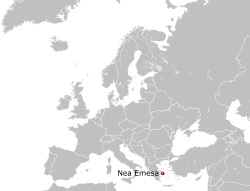La Luna
La Luna 月亮城 | |
|---|---|
Municipality | |
 | |
| Country | |
| Population (June 2023) | |
| • Total | 4(De-jure) |
| Demonyms | Lunista/Lunistas, Lunese |
La Luna is the capital city of Yusienia, the name means "The Moon". Before the name La Luna, it was named after the Finno-Swedish poet Edith Södergran. The literally meaning of the name in Swedish is "south fir tree". The name changed from "Nea Emesa" on 11 December 2022, and changed to "La Luna" on 24 November 2023.
History
Mycenaean Civillazation 1750BC-1050BC
Tyranny of Athens ?-508BC
Classical Athens 508BCE-322BC
Macedonian Empire 322BC-168BC
Roman Empire 168BC-395
Byzantine Empire 395-1205
Duchy of Athens 1205-1458
Ottoman Empire 1458-1821
First Hellenic Republic 1821-1832
Kingdom of Greece 1832-1924
Second Hellenic Republic 1924-1935
Kingdom of Greece 1935-1941
German puppet state 1941-1944
Kingdom of Greece 1944-1973
Hellenic Republic 1973-2021
Republic of Amazonia 2021-2022
P.R.R. of Yusienia 2022-Present
On 5 December 2021, Aurora Twinkle sneak attacked a piece of land of 1556 square meter in Exarchate of Great Ionia at night, and raised the flag of Amazonia at there, At the same time she announced Amazonia's sovereignty over this land, named it Nea Emesa. Imvrassia officials did not respond to this incident. After a few days, on 12 December, Twinkle move the capital to Nea Emesa.
Geography


Nea Emesa is located in Attic peninsula in the Balkans, and it's a landlocked enclave of Exarchate of Great Ionia, surrounded by fencing wire constructed by the Greek government. There's peak over 1 meter in the northwest corner of Nea Emesa. A tiny fortress called Elagabalupolis (Kathareousa: Ηλιογαβαλούπολη) is standing in the center of Nea Emesa. It is a fortress built using recycled materials and is planned to be used as a parliament building and government offices. Nea Emesa has some olive trees and fig trees. Hedgehogs, cats, Greek tortoises and pigeons are very common animals in Nea Emesa. Roman snails usually appear after rain.
Climate
Under the Köppen Climate Classification system, Nea Emesa has a warm-summer Mediterranean climate.
| Climate data for Agia Paraskevi | |||||||||||||
|---|---|---|---|---|---|---|---|---|---|---|---|---|---|
| Month | Jan | Feb | Mar | Apr | May | Jun | Jul | Aug | Sep | Oct | Nov | Dec | Year |
| Average high °C (°F) | 12 (54) |
12 (54) |
14 (57) |
19 (66) |
24 (75) |
29 (84) |
31 (88) |
31 (88) |
27 (81) |
22 (72) |
17 (63) |
13 (55) |
20.9 (69.7) |
| Daily mean °C (°F) | 8 (46) |
8 (46) |
10 (50) |
14 (57) |
19 (66) |
24 (75) |
27 (81) |
26 (79) |
22 (72) |
17 (63) |
13 (55) |
9 (48) |
16.4 (61.6) |
| Average low °C (°F) | 4 (39) |
4 (39) |
6 (43) |
9 (48) |
13 (55) |
18 (64) |
21 (70) |
21 (70) |
18 (64) |
13 (55) |
9 (48) |
6 (43) |
11.8 (53.3) |
| Average Precipitation mm (inches) | 44.7 (1.76) |
41.5 (1.634) |
39.2 (1.543) |
24.2 (0.953) |
13.7 (0.539) |
9.2 (0.362) |
5.4 (0.213) |
5.7 (0.224) |
12.2 (0.48) |
35.7 (1.406) |
59.1 (2.327) |
54.6 (2.15) |
345.2 (13.591) |
| Average precipitation days | 6.3 | 5.7 | 5.2 | 3.9 | 2.7 | 1.7 | 0.8 | 1.1 | 2.2 | 4.1 | 6.2 | 6.9 | 46.8 |
| Source: Weatherspark[1] | |||||||||||||
References
- ↑ "Climate and Average Weather Year Round in Agía Paraskeví". Retrieved 24 October 2023.